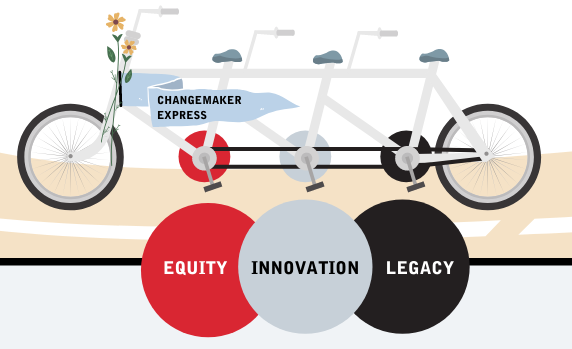By The Joining Vision and Action Team
Times of change can lead people to reflect on what is important and meaningful, and the JVA team is no exception. We have been considering what is most critical to our work, as well as what sets us apart. Three attributes stand out: innovation, equity and legacy. These aspects show up in all of our work, as we know they do yours.
To explore the topic further, we asked members of our team to share what innovation means to them and how they are using it to support JVA’s clients in this difficult time. Here are some of their thoughts:
What does innovation mean to you in terms of JVA’s work?
Grantwriting
Director of Grants Erin Shaver: We’re really willing to pivot with our clients; we are used to juggling a lot of different things, and we are not afraid or unable (actually, instead, quite well suited) to help think outside the box and strategize new ways of doing things when restrictions, funders, etc. have necessitated change in programming for services for our clients.

Lisa Cirincione: “A customized strategy is a key element of our innovation.”
Senior Resource Development Associate Lisa Cirincione: JVA’s grantwriters don’t typically get hired to simply be scribes. Clients value the experience and insight that our grantwriters bring to the table.
We start by helping them determine if their project is a good match with a particular funder and if so, how to strategically position the proposal so that the funder can easily see that it’s a good fit too. The work that we do to help develop a customized strategy is a key element of our innovation when it comes to grantwriting.
Senior Grantwriter Katalin (Kat) Wishart: We tailor contracts to clients’ needs and are trying to see how we can work with them, taking their current funding limitations into account. Also, we are developing new products to help serve clients who need support but have limited funding right now.
Evaluation
Managing Director/Director of Research and Evaluation Jill Iman: It means we are always working to stay ahead of the curve in terms of evaluating our approaches, our methods, our understanding of the sector, etc.—really, it’s that we’re not afraid to adapt and that, in fact, the expectation is that we should constantly be adapting and growing.

Jill Iman: “Really, it’s that we’re not afraid to adapt.”
We know what works and where/how we’ve been successful previously, but that’s because we’re always building upon our strong foundation through innovative practices.
Research and Evaluation Associate Aaron Schonhoff: Innovation for me is more of a continuous improvement process. Whether it is creating tools that streamline analysis or streamline data visualization into dashboards or finding ways to better get the data we need to speak to the answers our clients seek, I am constantly looking to improve the processes and techniques I use in my work to save time and get better results.
Planning and Facilitation
Director of Strategic Planning and Communications Nora Welch: Innovation means freedom to explore. It means temporarily disregarding traditional (and potentially “real”) boundaries of resources, information, people, processes, etc. It’s the willingness to say: Here’s the problem, what are all the ways that we could address that problem, even if they’re “impossible”?—in fact, especially if they’re seemingly imposible. It’s leaning into the good side of the “what if” questions, employing curiosity instead of concern.
This is one of my favorite parts of the strategic planning process—facilitating groups to think differently about the future, because the future doesn’t have to play by the same rules we’re playing by today. It’s a beautiful thing when people connect with that idea; people’s eyes light up and the ideas just flow.
That’s how change happens. It starts with changing how we’re thinking about change, and many times this is where innovation is born.
Special Pricing on New Sustainability Bundles
You’ve told us your immediate priorities are to increase funding and financial stability. So we’ve identified the top products and services to bolster your organization’s foundation—and we are currently offering them at a discount. Learn more here!
Is there a recent trend that has led to the need for/opened the door to an innovation in what you or JVA’s clients are doing?
Grantwriting

Kat Wishart: “Things keep changing, so grant proposal content keeps changing.”
Lisa: I’ve worked remotely for a decade, so this isn’t new to me. But, for most of my clients it is! We are all trying to figure out how get work done and give each other grace when partners, kids or dogs interrupt our Zoom meetings.
COVID is definitely causing many people to feel anxious about what the future will bring in terms of having enough income to keep doing their mission-driven work.
Kat: My clients are definitely being innovative to try to continue to serve their clients and stay relevant. I’m definitely spending more time talking to my clients to understand what they’re going through. I’m trying to help them convey the challenges they’re experiencing and their clients are experiencing through grants so they can get more funding.
Things keep changing, so grant proposal content keeps changing.
Evaluation
Jill: Lately, with the evaluation team, we’ve been approaching our work more through a developmental evaluation lens. In other words, developing questions, designing processes and analyzing data with an understanding that social change and the world are unpredictable—allowing us to develop more real-time feedback loops and reframe how we think about and interpret evaluation findings (i.e., being more contextual and flexible in our approach).
The need for this type of work has only been exacerbated by COVID as the world and the work of our clients are changing incredibly rapidly.
Bilingual Research and Evaluation Associate Silvia Solis: I have needed to shift my approach around community engagement by doing more extensive initial secondary data and literature reviews to inform primary research and adapt methods as needed.

Aaron Schonhoff: “We have had to get creative about how we offer incentives.”
Aaron: Some projects rely on a captive audience to ensure high response rates (e.g., classrooms or workshops) on feedback surveys. Due to the pandemic, we have had to move these online and get creative about how we offer incentives so we can try to ensure our response rates remain high.
Planning and Facilitation
Nora: Strategic planning is not on the top of most people’s lists right now because the future is so unknown at this point. It is, of course, unknown all the time … but the level of uncertainty and hesitancy is (reasonably) more.
All that being said, it’s still a super valuable component to have for reference and guidance. It helps provide more clarity in the chaos. Organizations that have a strategic plan that is clear and pointed, yet flexible, have an advantage in decision-making. Also, a good plan that includes direction yet lacks restriction or attachment to a certain way of doing things leaves room for innovation in response to environmental changes. Right now, speed and adaptability are important.
Also, organizations that have a current and well-defined core identity can find it to be extra useful when it comes to prioritizing what comes next, or what comes first over something else.
What are some ways innovation is now showing up in JVA’s work?
Team members listed the following:
- Our clients are pivoting in creative ways.
- I’m connecting more humanly and personally with the people I communicate with through my work—namely clients, community partners and participants of engagement efforts.
- Our grantwriting clients are innovating in that they hire us as a grantwriter, so they only pay for the grants JVA writes, as opposed to overhead and salary.
- We are providing contactless data collection.
- Our feedback and training engagements have moved online.
- We’ve shifted our mindset and use innovation to think about how we’re framing and presenting things. We try to think: How can we use this moment to create even more value for our clients and for our participants? How can we think about the future while acknowledging the truths about today?
- Specific to strategic planning, we’re innovating ways to incorporate our Technology of Participation principles with groups via remote meetings, so that we still provide multiple methods of adult learning and engagement (i.e., opportunities to share individually, in small groups and with everyone).
- Because we’re used to doing at least half-day, if not full-day, sessions, we’re also exploring how and where to break up our work and conversations so they match the attention and schedule capacity of our audiences.
JVA’s commitment to innovation and to equity, along with our 33-year legacy, are what differentiates us from other consultants that serve changemakers. Learn more about our mission, vision and core values on our About JVA page, and in more blogs to come.








Leave A Comment